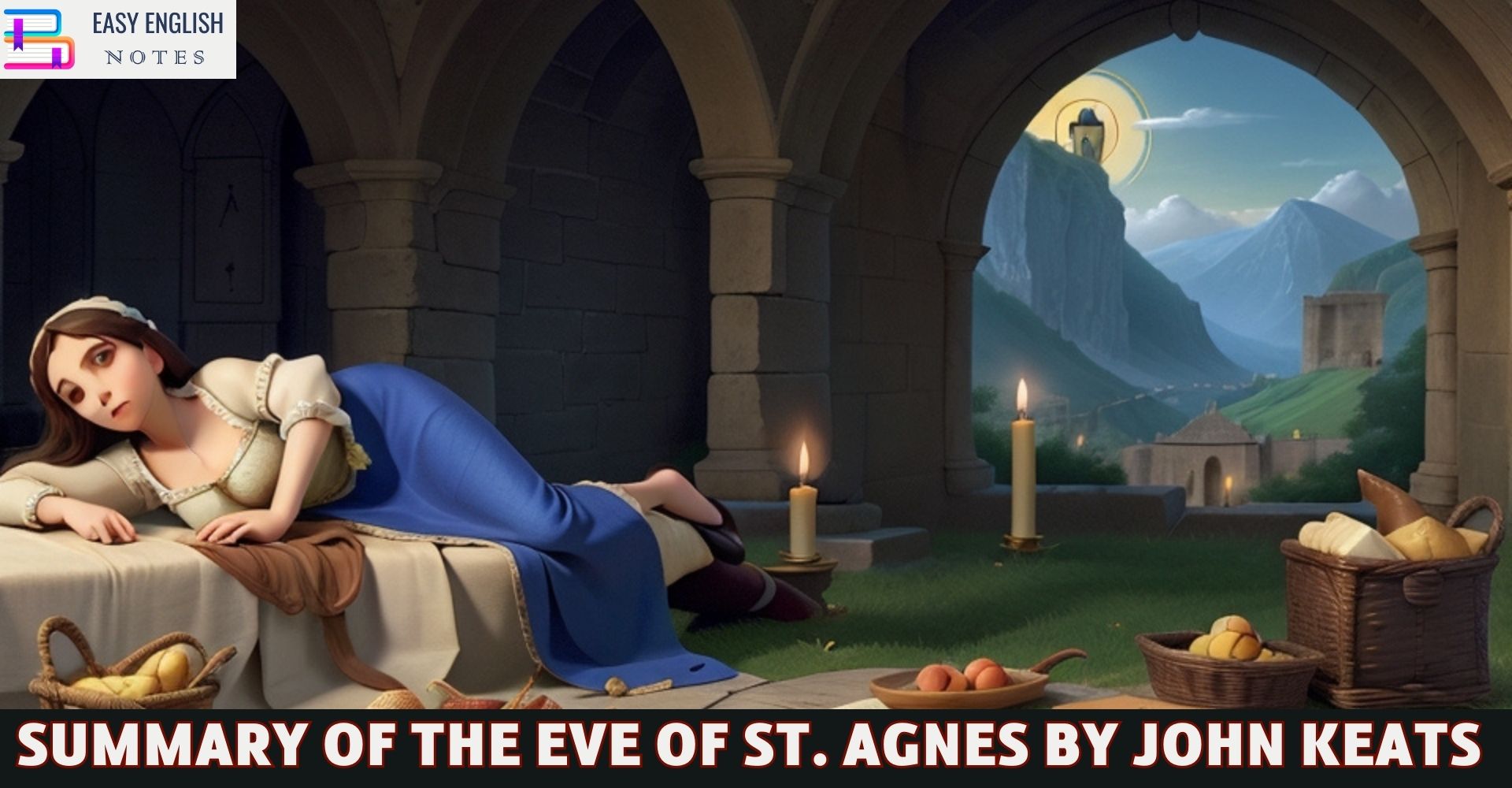In the heart of a medieval fortress, the scene unfolds. It’s the twenty-first day of January, the eve of the revered Feast of St. Agnes. Madeline, the daughter of the castle’s lord, is poised on the edge of midnight, filled with anticipation. She has been assured by wise elder women that through certain mystic rituals, the veil between reality and dream will thin, allowing her a magical glimpse of her beloved in her slumber’s embrace.
Wholeheartedly embracing this ancient belief, Madeline readies herself for the arcane customs, preparing to retire to her bed without supper, a necessary step. On the very same night, another figure moves silently through the castle’s shadows. Porphyro, deeply enamored with Madeline and reciprocated in affection, manages to infiltrate the castle unnoticed. A perceived adversary to Madeline’s kin, Porphyro’s presence would be met with hostility and danger. However, the castle’s festivities and the influx of guests provide a veil of anonymity.
In a serendipitous turn, Porphyro encounters Angela, Madeline’s loyal nurse and his confidante. Angela reveals to him Madeline’s peculiar superstition, an intimate detail of her beliefs. This sparks an audacious idea within Porphyro’s mind: to transform Madeline’s cherished conviction into tangible reality. He resolves to manifest himself in her chamber as the clock strikes midnight. With Angela’s reluctant assistance, he takes refuge within a concealed alcove in Madeline’s chamber.
In time, Madeline enters her haven, her thoughts consumed by the promise of an extraordinary vision. Slumber claims her, a sleep enchanted by the rites she’s performed. As the old beliefs promised, Porphyro appears in her dreams, an immortal figure woven from her deepest desires.
Upon Madeline’s sleep-laden state, Porphyro emerges from his hiding place and approaches her bedside, seeking to awaken her. However, his gentle whispers fail to stir her, her slumber bound by a “midnight charm” too potent to be broken. In a daring maneuver, he retrieves her lute and coaxes its melodious strings near her ear. Her eyes flutter open, yet the enchantment’s grip remains unyielding. Then, a poignant shift occurs—the magical trance dissipates, replaced by the harsh light of reality. Madeline now gazes upon a mortal Porphyro, stripped of the immortality of her dream. The contrast is stark, almost overwhelming; she even fears for his life.
Yet, the forces of enchantment are not to be underestimated. The boundary between the waking world and dream begins to blur as Porphyro, fueled by passion beyond mere mortals, merges with her dream-self. Their union transcends the earthly, merging them in a mystical marriage within her reverie.
Also Read :
- Compare Hamlet with Macbeth, Othello and other Tragedies
- “The Pardoner’s Tale” is the finest tale of Chaucer
- Prologue to Canterbury Tales – (Short Ques & Ans)
- Confessional Poetry – Definition & meaning
As the otherworldly union wanes, Madeline is beset by apprehension. Fearing abandonment, she voices her trepidation that Porphyro will leave her—like “a dove forlorn and lost.” Now addressing her as his bride, Porphyro implores her to forsake the castle, offering a new home beyond its walls.
Under the shroud of night, they depart the fortress, unnoticed by its denizens. As dawn arrives, the castle’s inhabitants are plagued by unsettling dreams, and both Angela and the aged Beadsman meet their end.
In “The Eve of St. Agnes,” Keats masterfully employs the metrical romance, a form embraced by medieval poets and later revived by romantics. This metrical pattern, the iambic nine-line Spenserian stanza, weaves a tapestry of narration. Keats’ deliberate choice both celebrates and disrupts narrative flow, akin to casting anchors at each stanza’s close.
Keats’ focus in “The Eve of St. Agnes” diverges from vivacious storytelling; rather, it reverberates with a reverence for romantic love. Characters take a back seat to an exploration of love’s celestial qualities, temporarily materialized through magic. The supernatural, a staple of romantic literature, forms a cornerstone of the narrative.
Descriptive prowess flourishes in the poem, akin to a canvas adorned with meticulous brushstrokes. Keats embraces every nuance, immersing readers in a sensory experience. The verses teem with vivid imagery, from moonlit windows to lustrous stained glass. This painterly approach serves to elevate romantic love to a divine plane.
Contrast emerges as a pivotal artistic device, elevating the narrative’s visual impact. Coldness magnifies the warmth of love; adversity sharpens affection’s intensity. Age and youth, scarcity and opulence, all intertwine, enriching the emotional fabric.
Sight is the chief sense engaged, exemplified by the mesmerizing stained glass. A window “diamonded with panes of quaint device” transforms Madeline into a “splendid angel,” a testament to Keats’ profound engagement with the sense of sight.
Amid the lush tapestry, a poignant mystery arises in the final stanza. Angela and the Beadsman, agents of love’s fulfillment, meet their demise. Keats may have envisaged consequences for Angela’s complicity or sought closure through the Beadsman’s end. Their fates ultimately serve as the finale’s punctuation.
In the mosaic of “The Eve of St. Agnes,” Keats binds romanticism with the supernatural, employing a palette of contrasts. Each stroke of his narrative brush kindles sensory immersion, conjuring a tale where love’s ethereal essence transcends mortal boundaries, a resonant echo of Keats’ own experience of ardor.
PLEASE HELP ME TO REACH 1000 SUBSCRIBER ON MY COOKING YT CHANNEL (CLICK HERE)











